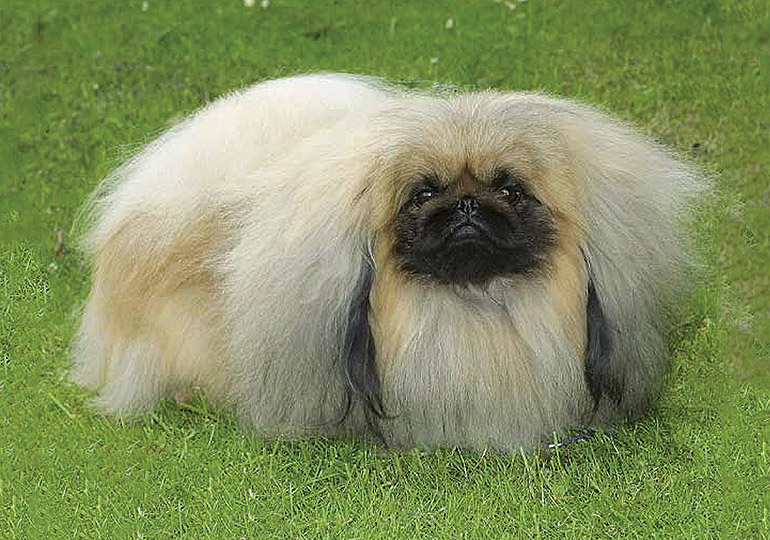Breeds
Pekingese

GROUP 1 - TOYS
History
An ancient Chinese legend tells of a lion that fell in love with a little monkey and was faced with a choice – it could keep its size and power, or sacrifice them for the companionship of the monkey. The lion chose the monkey, and various versions of the legend have the Pekingese as either the lion, having sacrificed its size, or the offspring of the lion and the monkey. Told either way, the legend reflects the proud, noble bearing of the Pekingese.
One of the oldest breeds, the Pekingese is named for the Chinese city of Peking (now Beijing), where the little dogs were kept by members of the Chinese Emperor’s household. Pekingese were seen as sacred dogs, and could only be kept inside the walls of the Forbidden City, the Chinese Imperial Palace built in the 15th century. The penalty for anyone found with a Pekingese outside the walls of the Forbidden City was death.
In 1860, when British and French forces invaded the Forbidden City, it is said that they found five Pekingese guarding the body of an elderly aunt of the Emperor who had chosen to commit suicide rather than face the revolutionaries. Four female and one male Pekingese were taken to England by Lord Hay that year. One of those Pekingese, named ‘Looty’, was given to Queen Victoria, and the others to English nobles who bred them; the breed was first shown in England in 1904. Around the turn of the century, Pekingese were given as gifts to prominent people in several countries, and the breed soon gained popularity around the world.
Characteristics
The Pekingese is small, well-balanced and ‘surprisingly heavy’ when picked up, according to the standard. It should have a sense of dignity and quality, enhanced by a high-set tail, carried slightly curving over the back, with long feathering.
Temperament
It is an alert dog, and inquisitive about what is happening around it. When aroused, the Pekingese has a unique expression – its eyes come alive. According to the standard, it is ‘fearless, loyal, aloof but not timid or aggressive’. Loyalty is one of the strongest Pekingese qualities; it would protect anything it thought belonged to it.
Appearance
A leonine appearance is suggested by the thick-set body, distinct waist and long, straight coat with profuse mane forming a cape around the neck. The Pekingese has a coarse topcoat with a thick undercoat, of all colours and marking except albino or liver – particolours are predominantly white and evenly broken. Pigmentation on nose, lips and eye rims must be black.
The head should be large and rectangular, and the broad, wide skull should be flat between the ears. The placement of the ears is important to the appearance of the skull – low ears will lend the skull a ‘domed’ look, while ears set too high will make the head appear square.
The muzzle should be almost as wide as the broadest part of the skull, short, wide and well-cushioned, with a firm, wide underjaw; it should not overhang the chin. The Pekingese nose should be short, broad and black, with large, open nostrils. Eyes should also be very dark, round and lustrous.
For its small size, the Pekingese is surprisingly sturdy. Dogs weigh up to 5kg, and bitches up to 5.4kg.
Maintenance & Suitability
The amount of maintenance your Pekingese requires depends on its coat. Keeping a Pekingese in full coat requires daily brushing and the careful removal of dirt from facial creases and around the eyes. Use a cotton wool ball dipped in warm water and a few drops of gentle shampoo.
Full bathing should be kept to a minimum – once a month is generally sufficient. It can be more simple to keep a non-showing Pekingese trimmed in a ‘puppy cut’; daily brushing is still ideal, but is not as much work, and the short coat makes drying much easier after a bath.
Words: Bruce Marquette, Frances Wickens and Sylvia O'Cass
Image: Michael Trafford Photography
In Conclusion
Now you know a little about the Pekingese, you may think that this is the dog for you. Before you make a decision, please make contact with the breed club or your State controlling body for purebred dogs. They will be able to give you information about available puppies and also suggest dog shows where you can see the breed and speak to breeders. In this way you will gain a better perspective of the Pekingese and its needs, and whether this breed would suit your lifestyle.


